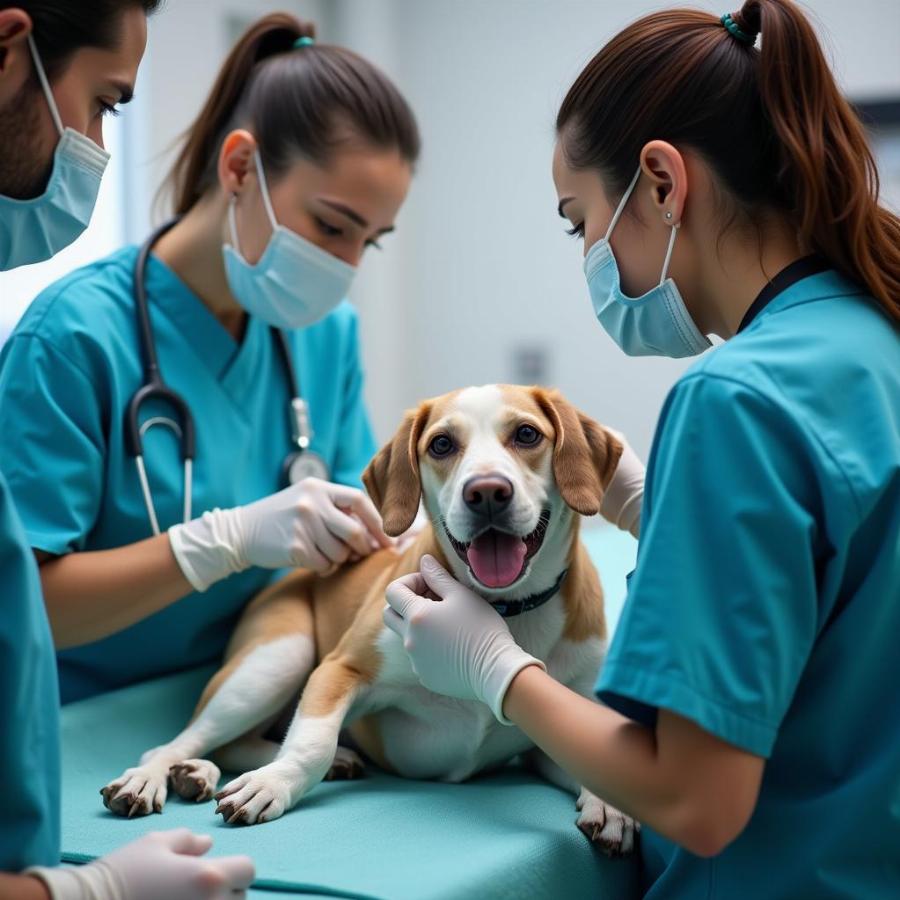Dog cosmetic surgery, a complex and often controversial topic, involves surgical procedures performed on dogs primarily to alter their physical appearance rather than for medical reasons. While some procedures, like tail docking and ear cropping, are deeply rooted in tradition and specific breed standards, others are purely cosmetic and raise ethical questions about animal welfare. Understanding the reasons behind these procedures, their potential benefits and risks, and the ethical considerations is crucial for any responsible dog owner.
Understanding the Motivations Behind Dog Cosmetic Surgery
Why do some owners choose cosmetic surgery for their dogs? Motivations vary. Some believe certain procedures, like cane corso dog ear cropping, enhance breed-specific aesthetics or functionality. Others opt for procedures like dog ears tummy tuck believing it will improve their dog’s comfort or prevent future health issues. Still others might pursue purely cosmetic alterations for personal preference.
 Dog Cosmetic Surgery: Enhancing Beauty or Crossing a Line?
Dog Cosmetic Surgery: Enhancing Beauty or Crossing a Line?
Breed Standards and Traditional Practices
Historically, certain breeds underwent procedures like tail docking and ear cropping for practical reasons, such as preventing injuries during work or hunting. Today, these practices continue, often driven by breed standards and show ring expectations. However, the necessity and ethics of these procedures are increasingly debated.
The Ethical Dilemma of Dog Cosmetic Surgery
The ethical considerations surrounding dog cosmetic surgery are paramount. Is it right to subject a dog to a surgical procedure, with its inherent risks, solely for aesthetic purposes? Does altering a dog’s natural appearance infringe on its well-being? These questions spark passionate debate among veterinarians, animal welfare organizations, and dog owners alike.
Weighing the Risks and Benefits
Like any surgical procedure, dog cosmetic surgery carries potential risks. These can include complications from anesthesia, infection, bleeding, and pain. Weighing these risks against the potential benefits, particularly when the benefits are purely cosmetic, is a crucial part of responsible decision-making.
Types of Dog Cosmetic Surgery and Their Implications
Dog cosmetic surgery encompasses a range of procedures. Some common examples include:
- Ear Cropping: Reshaping the ear cartilage, often performed on breeds like Doberman Pinschers and Great Danes.
- Tail Docking: Shortening the tail, traditionally practiced in breeds like Rottweilers and Boxers.
- Dewclaw Removal: Excising the extra toe on a dog’s leg.
- Skin Fold Reduction: Often performed on breeds with excessive skin folds, such as Bulldogs and Shar-Peis, to prevent infections.
Alternatives to Cosmetic Surgery
For some aesthetic concerns, non-surgical alternatives exist. Eye patches for dogs can address certain eye conditions without invasive procedures. For other issues, careful grooming, proper nutrition, and addressing underlying health problems can often achieve desired results without resorting to surgery. Dog contact lenses can even offer aesthetic changes without the need for surgery.
Making Informed Decisions about Your Dog’s Well-being
Ultimately, the decision to pursue dog cosmetic surgery is a personal one. However, it’s a decision that should be made with thorough research, careful consideration of ethical implications, and a deep understanding of your dog’s individual needs and well-being. Consulting with a veterinarian is paramount to understanding the risks and benefits and exploring alternatives. Always prioritize your dog’s health and happiness above aesthetic preferences.
Conclusion
Dog cosmetic surgery is a complex topic with ethical, practical, and emotional implications. While some procedures aim to improve a dog’s health or comfort, others are purely cosmetic. Responsible dog owners must weigh the risks and benefits, consider ethical implications, and prioritize their dog’s overall well-being when making decisions about cosmetic procedures. Always consult with a veterinarian to ensure informed choices. Remember, loving and caring for your dog goes beyond physical appearance.
FAQ
- Is dog cosmetic surgery painful? Yes, like any surgery, it involves pain, though pain management is provided.
- Are there risks associated with dog cosmetic surgery? Yes, risks include infection, bleeding, and complications from anesthesia.
- Are there alternatives to dog cosmetic surgery? Yes, alternatives can include grooming, nutrition, and addressing underlying medical conditions.
- Is dog cosmetic surgery regulated? Regulations vary by location and procedure.
- What is the recovery time for dog cosmetic surgery? Recovery time varies depending on the procedure.
Do you have further questions? Check out these related articles:
Beaut Dogs is your trusted source for comprehensive information on all aspects of dog care, from breed selection to specialized guidance on health, nutrition, training, and more. We are dedicated to providing valuable resources and empowering dog owners to make informed decisions about their beloved companions. For personalized guidance, please contact us at Email: [email protected]. Beaut Dogs is here to help you navigate the wonderful world of dog ownership.